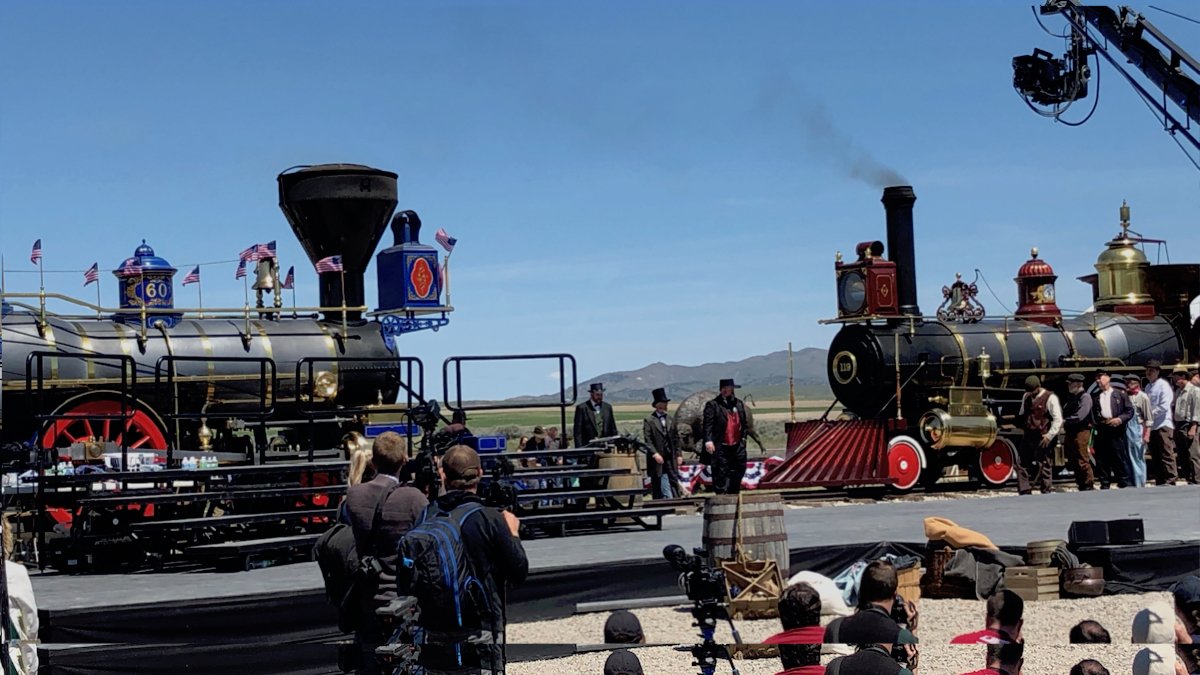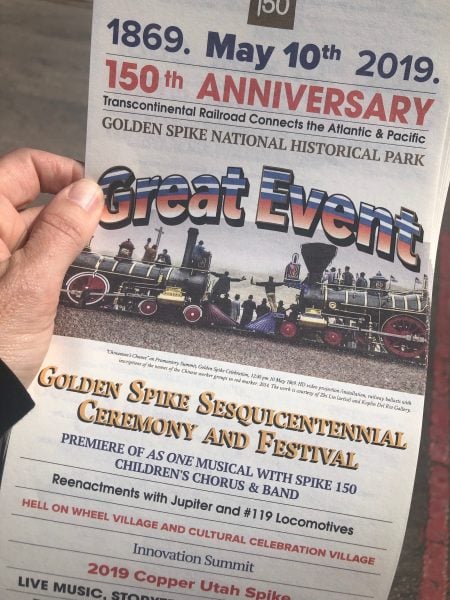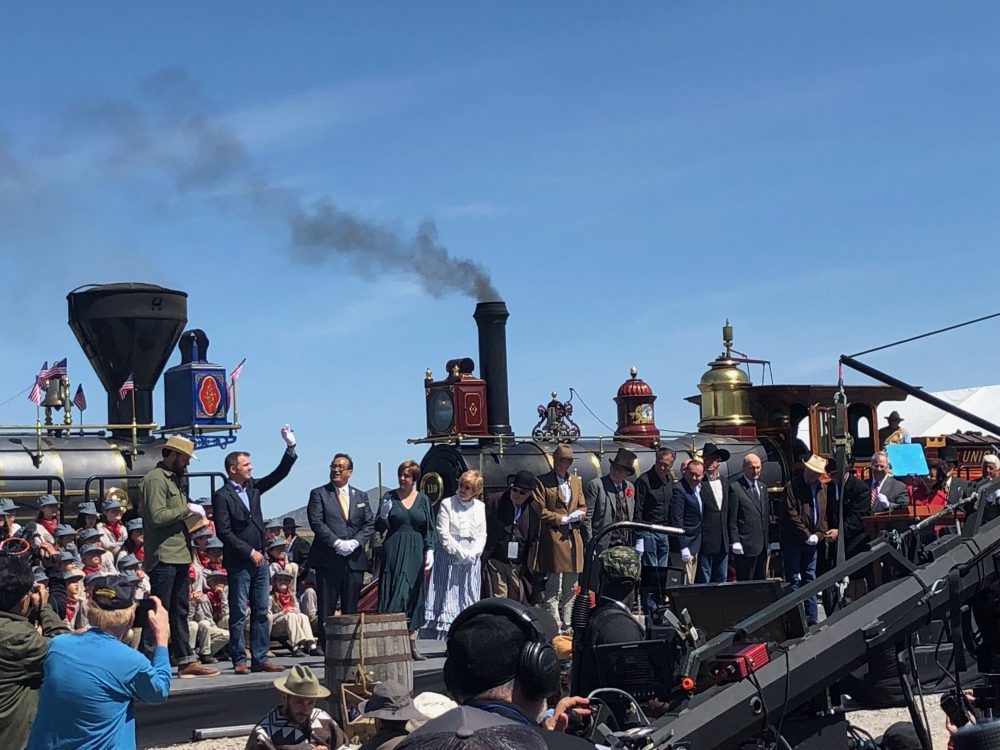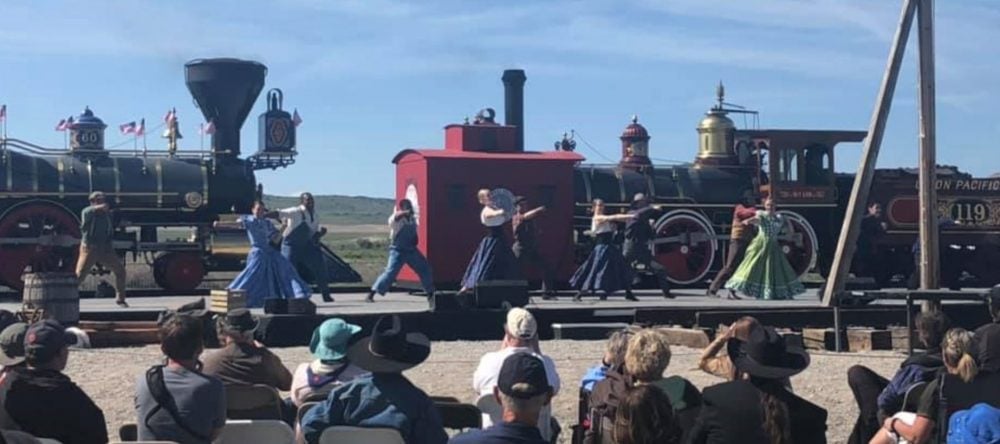
Last weekend, my husband and I had the opportunity to celebrate history unlike anything we had done before. We got tickets to the Golden Spike Sesquicentennial Ceremony and Festival at the Golden Spike National Historic Park near Promontory, Utah. The event was held on May 10th, and the reenactment of the driving of the spike happened within minutes of when it would have been exactly 150 years ago: 12:47pm on May 10, 1869.
For those who aren’t in the know, despite our having degrees in science fields, my husband Dave and I are history geeks. Not long after we got married, we fell into a circle of friends who did Civil War reenacting. We were living in western Louisiana at the time, and we discovered reenacting as a fun twist on camping. We ended up performing reenactments quite a bit right up until we had our sons.
The Transcontinental Railroad has been called America’s 19th century moon shot. The irony isn’t lost on many that these two events occurred 100 years and 2 months apart. President Lincoln signed an authorization during the Civil War allowing funding and land to make this project happen, but it took the innovation, ideas, and ingenuity of thousands more to bring it to fruition. While not a perfect project, the “Transcon” is still cited routinely as an example of government and private industry working together, and of what can be done with large goals are placed in America’s hands to execute.
Some Air Force friends who now live near Salt Lake City extended us an invitation to join them at the event, and we jumped on the opportunity. The state of Utah, as well as the National Park Service, pulled out all the stops this weekend. Read on to learn more about our weekend.
The Ceremony
We flew into Salt Lake City airport pretty late on Thursday night — well after midnight — and needed to hit the road for the one hour drive up to Golden Spike National Historic Park the very next morning. To get vehicle access into the park on May 10th, visitors needed to purchase parking passes ahead of time, at $10 per vehicle. My husband and our friends each got one. And those tickets sold out pretty quickly; we were pretty excited to have gotten a pair. Those who didn’t purchase the parking passes could still get to the event via shuttle buses, but I expect that method was a bit more complicated.
What should have taken us one hour was more like 1 1/2 hours. After exiting Interstate 15 towards the park, it’s about a 30 mile drive west-northwest. The last 10 miles of the drive was stop-and-go just about the whole way. Thankfully there were no cattle drives going on, which stopped traffic on my family’s 2015 trip.
We arrived and found a viewing spot with just 15 minutes to spare before the start of the ceremony. Our party seriously lucked out: there was a spot blocked by a large camera arm apparatus. There weren’t many people near the camera arm. Our friend hinted that the arm would probably lift up out of our way at the start of the ceremony. By golly, he was right! We had a fantastic view once the ceremony started! In addition, we couldn’t have asked for better weather! Few clouds with temperatures in the 60s (Fahrenheit).


The first hour of the event was a series of remarks by politicians (such as the governor of Utah), descendants of railroad workers (Connie Young Yu, the descendant of a Chinese Central Pacific railroad worker) gave the opening remarks, and historian/authors, including presidential historian Jon Meacham delivering the keynote. Meacham’s address was my favorite part of the entire day and I am thrilled to have found a video to share! It’s worth watching and listening to — Meacham did a wonderful job making connections between what happened 150 years ago…and now.

After the political parts, and the addresses were done, there was a musical celebration, and at around 12:15pm, the reenactment began. The reenactors live in the local area, perform on weekends and holidays at the park during the warm season, and know their speeches cold. I captured the end of the reenactment for you in the video below:
The last 30 minutes of the two-hour ceremony consisted of a musical that was commissioned for the event: As One is a musical telling of the history of the Transcontinental Railroad. Unlike many of the versions of the history we might have seen in history books growing up, this play makes a point to include the stories of the Chinese, Irish, Native American, and recently-emancipated slaves. In the spirit of Hamilton, the cast upends what your mind was accustomed to, casting a child as Abraham Lincoln, and a young woman as Union Pacific chief engineer Grenville Dodge.
The play concluded with a playing of the national anthem, complete with fireworks (yes, during the day), and four F-22 jets in a flyover.
The Centennial Controversy
The last time a Golden Spike commemoration of this size occurred was on May 10, 1969. It was a much smaller event, in part because the Golden Spike National Historic Site was just opening, timed with the centennial. There was room for no more than about 3,000 spectators, many of whom were specific invited guests. One of the cool things about the 1969 commemoration was the driving of the last spike. Like in 1869, it was wired to complete a circuit sending a telegraph signal to President Richard Nixon himself.
However, there were many un-cool things about the 1969 event. Topping the list was the exclusion of any Chinese Americans from the program. The Chinese Historical Society of America was excited for the chance to be featured in the program, having coordinated with Secretary of Transportation John Volpe for a five-minute piece of the ceremony. However, the group ended up excluded, and the rumor is that their part of the program was cut out in favor of the opportunity to feature John Wayne.
Just following the 1969 ceremony, the Society was able to erect a pair of bronze plaques, one in Sacramento on the western end of the Central Pacific Railroad line, and one at the eastern end in Promontory. It was a much-more-quiet commemoration.

For this past weekend’s event, there were multiple opportunities to honor the Chinese contributions, starting with Connie Young Yu’s opening remarks. She was given the 5 minutes in the program that was taken from her family, as her father was one of the few Chinese Americans in attendance in 1969. She was very blunt in her remarks: in 1969 they were forgotten, but this year they are proud to be in attendnace by the thousands. The last word of her address was timed with the 11:00am official start to the ceremony: DONE!
In addition to Ms. Yu’s powerful words, Secretary of Transportation Elaine Chao, a Chinese American herself, was in attendance and was one of the keynote speakers.

Finally, there was a taped address by the Chinese ambassador to the United States, Cui Tiankai, presented to the crowded via large video screens. Ambassador Cui spoke to the railroad serving as an example of what people from different backgrounds can do, when presented with a common goal.
Well over 1000 Chinese Americans, representing the Chinese Railroad Workers Descendants Association, were present at the ceremony on Saturday. The photo featured in this article says it all.
As a half-Chinese American myself, seeing the contributions of this group honored and remembered 150 years later truly brought tears to my eyes.
While the exclusion of the Chinese American contributions garnered a lot of attention after the 1969 event, we can’t forget that there were significant Native American and African-American contributions as well. They were similarly excluded in 1969, but certainly received their due honor this past weekend. Read on to learn more.
The Inclusivity
The inclusive nature of this past weekend’s event was clear to everyone. It clearly emerged, starting with the event’s motto, “As One”. Congratulations, Spike 150, you got it right!
One look at the program, and the diversity was apparent:
- Opening remarks by historian Connie Young Yu, herself the descendant of a Transcontinental Railroad worker
- Invocation and blessing by Shoshone Tribal Elder Rios Pacheco
- Address by Secretary of Transportation Elaine Chao
- Video address by Chinese ambassador to the United States, Cui Tiankai
- Address and toast by the Irish ambassador to the United States, Daniel Mulhall
- A diverse cast featured in the musical performance, As One

Other Events in the Area
There were dozens of other things going on that weekend throughout the state of Utah, celebrating the sesquicentennial. Many of the events are ongoing throughout the spring and early summer. Our family chose to visit the Ogden Heritage Festival near the city’s Union Station. This is where the Union Pacific Historical Society and Southern Pacific Historical and Technical Society were holding a joint convention.
Why Ogden? Because the Union Pacific arranged an amazing showcase of historic steam locomotives, including the number 4014 “Big Boy” steam locomotive, the first one of its kind to run under its own power since the 1960s. It had been undergoing a massive restoration since 2013, and was able to run itself from Cheyenne, Wyoming to Ogden, Utah for last weekend’s events.
For those like my husband, this was as much a reason for our journey from Colorado as the Golden Spike ceremony. Enjoy this video our friend took of the Big Boy locomotive’s arrival in Ogden on May 8th.
Also, the Mormon Tabernacle Choir and Utah Symphony had special commemorative performances in Salt Lake City that weekend, and the Utah State Capitol building exhibit hall is hosting three of the four commemorative spikes, including the original “Golden Spike” through the end of June. The Golden Spike is on loan from Stanford University for the anniversary events.
Finally, the musical, As One, was continuing performances throughout the weekend.
Golden Spike National Historical Park Today
One of the highlights of the weekend was the official recognition of the Golden Spike National Historic Site being “upgraded” to the Golden Spike National Historical Park, thanks to President Trump signing the Natural Resources Management Act this past March. Utah is particularly proud of this designation because it officially gave the state its SIXTH national park (although I’d argue that a National Historical Park isn’t quite the same as the classic National Park, such as Yellowstone or Shenandoah.) A delegation of Utah leaders: members of Congress, both Senators, former Senator Orrin Hatch, the governor, and the president of the Church of Jesus Christ and Latter Day Saints, officially unveiled a new welcome sign for the park as part of the Spike 150 ceremony.
The reenactments still occur daily during the warm weather months when the locomotives can come outside to take part, but the park itself is open year-round. Read more about taking your family to the National Historic Park here.
What a great weekend we had! If you’re looking for an off-the-beaten path trip into history, I do recommend this park. I’m afraid another commemoration of that size won’t be coming along for a while…but don’t worry! The Geek Family will be bringing you Apollo 11 anniversary coverage within the month!



What a great event! I ran a music history camp for kids many years ago about the Wild West and we certainly covered the importance of the railroad and sang both Chinese and Irish songs about it, learning about both cultures that contributed so much. The materials I had did not say much about the Native and African American contributions, so thanks for bringing it to light with your coverage. I’m a history nerd too!
I admittedly never gave much thought to the Native American and recently-emancipated slave contributions either, but it certainly makes sense. Reading the book and/or watching the drama “Hell on Wheels” brings some attention to the diversity also.